21 Best Native Plants for Florida
BY MELANIE JOSEPH | MAY 8TH, 2023 | FLORIDA, LAWN CAREFrom the wetlands of the Everglades to the sunny beaches of Miami, the Sunshine State’s diverse landscapes offer a wealth of natural beauty. It’s home to 1,197 statute miles of coastline, 825 miles of pristine beaches, and a vast array of stunning native plants. Florida’s flora not only provides visual appeal but also supports a healthy and diverse ecosystem.
Native plants offer several advantages over non-native species, including:
- Better adapted to Florida’s climate and soil
- Require less fertilizer and water than non-native species
- Promote biodiversity and help preserve Florida’s unique natural heritage
- Provide essential habitat and food for wildlife
- Lower maintenance costs over time
Whether you’re looking to create a vibrant garden or enhance your property’s natural beauty, incorporating the best native plants for Florida is an excellent place to start.
In this article, we’ll cover:
- 21 Best Native Plants for Your Florida Yard
- American Beautyberry
- Beach Sunflower
- Black-Eyed Susan
- Blanketflower
- Blazing Star
- Butterfly Milkweed
- Carolina Jessamine
- Coontie
- Coral Bean
- Coral Honeysuckle
- Ear-Leaved Tickseed
- Firebush
- Florida Anise
- Oakleaf Hydrangea
- Pink Pinxter Azalea
- Saw Palmetto
- Scarlet Sage
- Southern Live Oak
- Southern Wax Myrtle
- Texas Star Hibiscus
- Walter’s Viburnum
- How to Choose Native Plants for Your Florida Landscape
- FAQ About Native Florida Plants
- Where to Find Native Plants in Florida
21 Best Native Plants for Your Florida Yard
From showy wildflowers and groundcovers to majestic trees and shrubs, these native plants will enhance your landscape while also supporting the state’s ecosystem:
1. American Beautyberry (Callicarpa Americana)
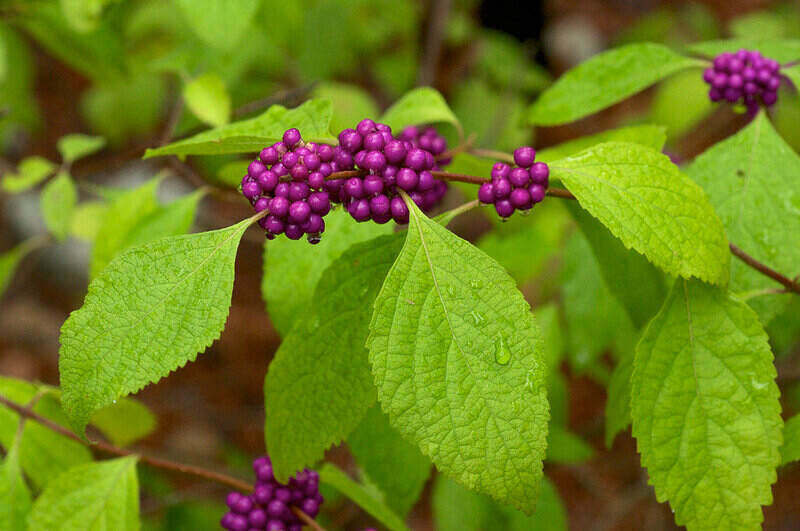
Photo Credit: Eric Hunt / Wikimedia Commons / CC BY-SA 3.0
Commonly found in Florida, this beautiful native shrub is an excellent choice for homeowners in Central and North Florida, as it is more tolerant of colder temperatures than other tropical plants in South Florida. In its natural habitat, American beautyberry grows in various areas, including hammocks, pine rocklands, and wetlands.
It typically blooms from June to August, producing small pinkish-purple flowers that are attractive to bees and other pollinators. The plant then produces clusters of bright purple berries in the fall – a favorite food of many species of wildlife, including birds and small mammals.
The best time to plant American beautyberry is in the fall or winter, as this allows the plant to establish a robust root system before the heat of summer arrives. Pruning can be done in the winter to promote healthy growth and a more attractive shape.
Growth habit: Shrub
USDA Hardiness Zone: 6b-11
Mature size: 3-8 feet tall, 4-8 feet wide
Duration: Perennial
Foliage: Deciduous
Sunlight needs: Partial shade to full sun – requires at least four hours of direct sun exposure
Soil preferences: Grows well in most soil conditions but prefers fertile, organic loam soil
Water needs: Low – around 1 inch of water per week, but it needs deep, slow watering during dry spells
Potential hazards: Non-toxic, but its berries may cause discomfort like vomiting if ingested
2. Beach Sunflower (Helianthus debilis)
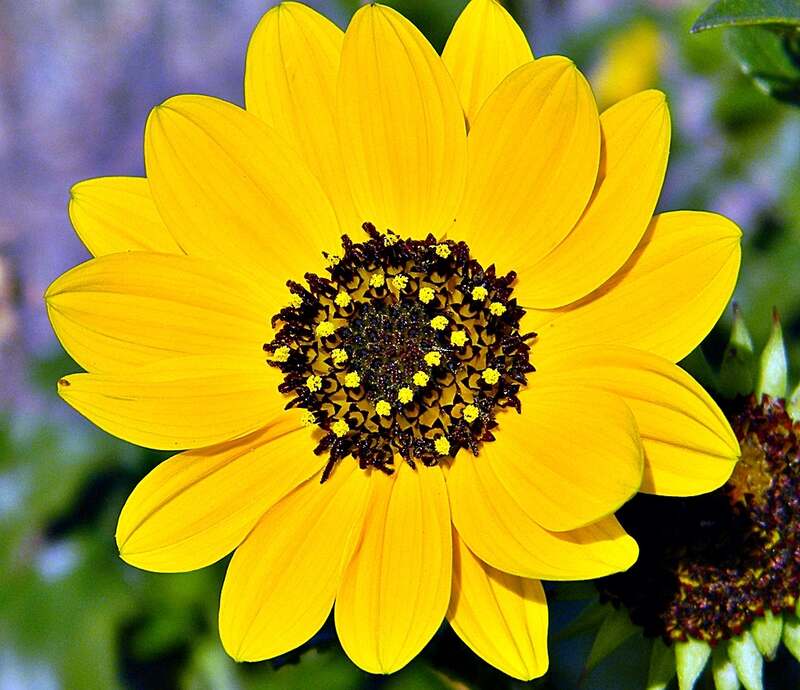
Photo Credit: Bob Peterson / Wikimedia Commons / CC BY-SA 2.0
Beach sunflower is a popular plant due to its hardiness and beautiful, sunny blooms. It thrives in sandy soil, making it an excellent choice for coastal gardens. This perennial plant can be found throughout the state, including the Panhandle.
With green, slightly hairy leaves, beach sunflowers produce small, bright yellow flowers that bloom year-round in warm climates. With a daisy-like appearance and papery texture, the clusters of flowers attract pollinators like bees and butterflies. It also serves as a host for the larvae of the Gulf fritillary butterfly.
This perennial plant does well in dry conditions but can benefit from regular watering to promote healthy growth and flowering. It’s relatively low-maintenance and requires little attention once established, making it an excellent choice for homeowners looking for a plant that requires minimal effort.
Growth habit: Flower
USDA Hardiness Zone: 8b-10
Mature size: 2-4 feet tall, 2-4 feet wide
Duration: Perennial
Foliage: Semi-evergreen
Sunlight needs: Full sun, but can tolerate partial shade
Soil preferences: Well-drained, acidic to alkaline, sandy soil
Water needs: Low
Potential hazards: Non-toxic
3. Black-Eyed Susan (Rudbeckia hirta)
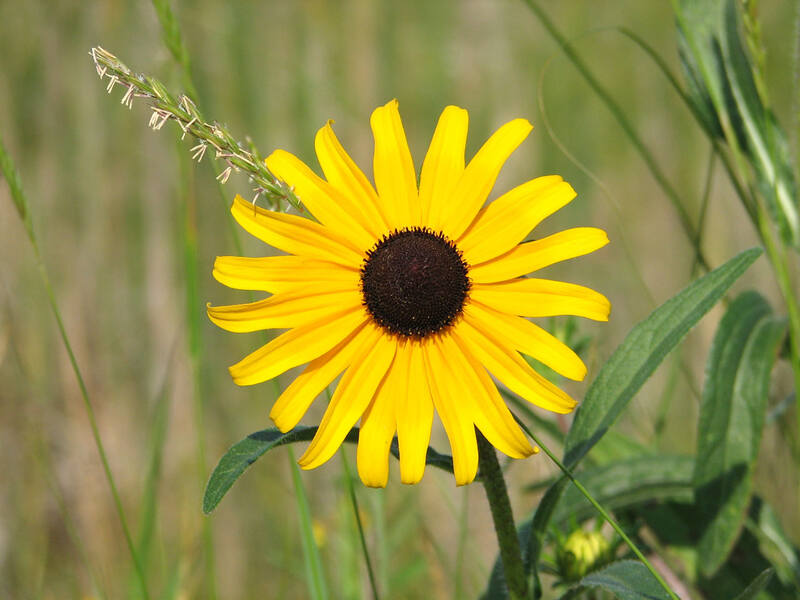
Photo Credit : PublicDomainPictures
Another native plant that can thrive in gardens throughout the Sunshine State, the black-eyed Susan is commonly found in meadows, prairies, and along roadsides. This perennial wildflower is a hardy plant that’s easy to grow and care for. It doesn’t need a lot of water and can handle drought conditions, making it an excellent choice for Florida’s hot and humid climate.
Black-eyed Susan is a larval host for the silvery checkerspot butterfly and serves as a habitat for lacewings and ladybugs. From late spring through fall, it produces golden yellow petals with dark brown or black centers that resemble an eye. These flowers are a favorite among pollinators like bees and butterflies.
Reaching up to a few feet tall, black-eyed Susan can be a great addition to mixed borders or as a backdrop for smaller plants. Remember to deadhead spent flowers regularly to encourage more blooms.
Growth habit: Wildflower
USDA Hardiness Zone: 3-9
Mature size: 2-4 feet
Duration: Short-lived perennial, annual, or biennial (depending on growing conditions)
Foliage: Deciduous
Sunlight needs: Full sun to partial shade – it requires at least six hours of sun exposure each day
Soil preferences: Well-drained, fertile, acidic, loamy, sandy soil
Water needs: Low
Potential hazards: Non-toxic to humans and pets, but may cause allergic skin reactions and asthma attacks
4. Blanketflower (Gaillardia pulchella)
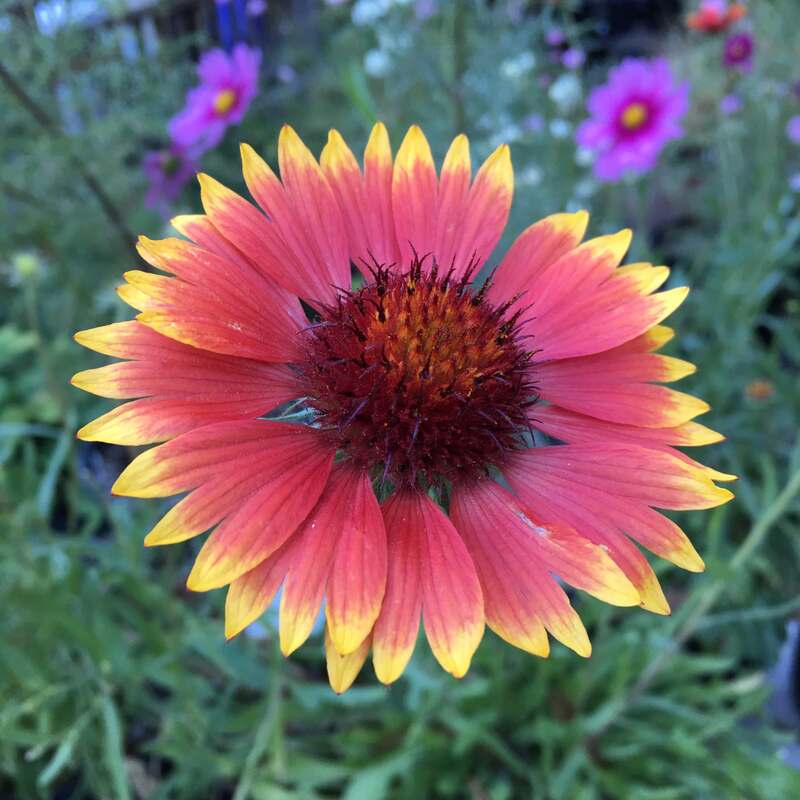
Photo Credit: Macdon / Wikimedia Commons / CC BY-SA 3.0
Native to the southeastern United States, blanketflower is a colorful and easy-to-grow plant. This member of the Aster family is best suited for gardens in Central and South Florida, as it prefers warm temperatures and well-drained soil. But it can grow in North Florida with proper care and protection during colder months.
Often found along roadsides, as well as in fields and meadows, this plant blooms from spring to fall. Its leaves are lance-shaped and typically green or gray-green, while its flowers come in various colors, including red, orange, yellow, and pink. The flowers have a unique shape with a central disk surrounded by colorful petals, resembling a miniature sunflower.
This perennial wildflower doesn’t require much watering once established, as it is drought-tolerant and can handle high temperatures. You can plant it in groups for a colorful mass effect. Plus, you may deadhead spent flowers to encourage more blooms.
Growth habit: Wildflower
USDA Hardiness Zone: 3-10
Mature size: 1-3 feet tall
Duration: Perennial
Foliage: Deciduous
Sunlight needs: Full sun
Soil preferences: Well-drained, dry, acidic, sandy soil
Water needs: Moderate
Potential hazards: Non-toxic, but may cause skin irritation
5. Blazing Star (Liatris spicata)
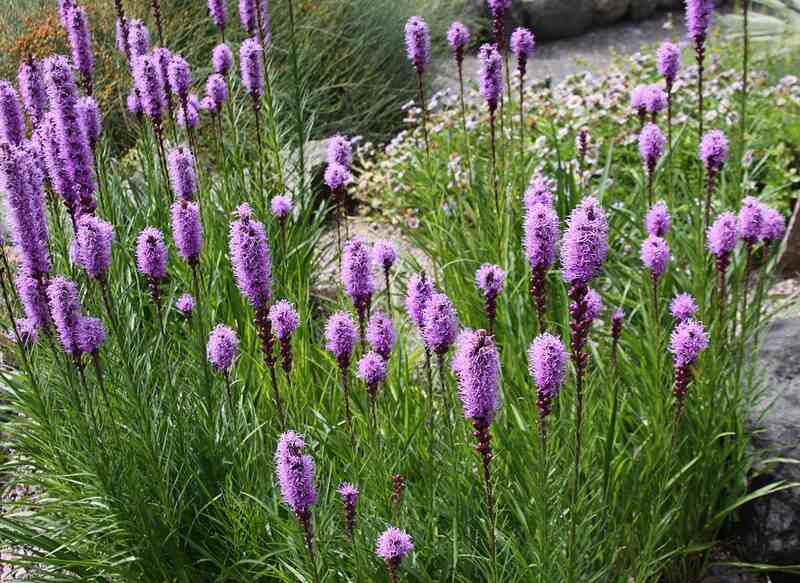
Photo Credit: Drew Avery / Wikimedia Commons / CC BY 2.0
Naturally found in prairies, savannas, and open woodlands, blazing star blooms in mid-summer to early fall. It produces tall spikes of vibrant pink or purple flowers that attract pollinators like butterflies, bees, and hummingbirds. This deciduous wildflower is a host plant for the rare Liatris butterfly, making it ideal for butterfly gardens.
To add more appeal to your garden, plant blazing stars in groups for a dramatic effect. You may mix it with other wildflowers for a more natural look. It’s best suited for homes in Central and North Florida, although it also can thrive in South Florida with proper care. The best time to plant this wildflower is in the spring, after the last frost.
Growth habit: Wildflower
USDA Hardiness Zone: 3-9
Mature size: 2-4 feet tall, 1-2 feet wide
Duration: Perennial
Foliage: Deciduous
Sunlight needs: Partial shade to full sun – it grows well in areas that get six or more hours of sun exposure a day
Soil preferences: Well-drained, moist, loamy soil
Water needs: Low
Potential hazards: Non-toxic, but it’s not recommended to ingest its leaves and flowers
6. Butterfly Milkweed (Asclepias tuberosa)
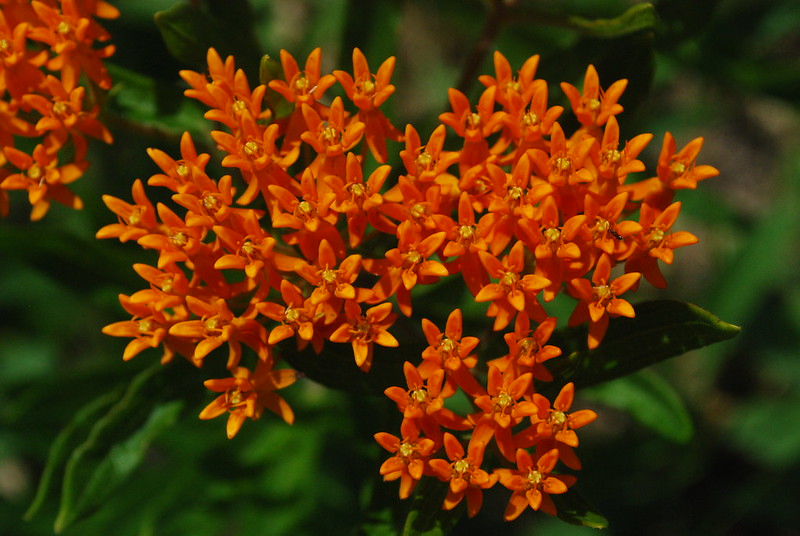
Photo Credit: Joshua Mayer / Flickr / CC BY-SA 2.0
Butterfly milkweed is a beneficial plant for Florida homeowners looking to attract pollinators to their gardens. It is best suited for Central and South Florida properties, as it is native to the state and can thrive in the warm, humid climate.
Commonly planted in areas with well-drained soil, butterfly milkweed blooms in the summer months, typically from June to August, and attracts a variety of pollinators, including butterflies, bees, and hummingbirds. It’s also a larval host plant for the monarch butterfly.
This perennial plant’s leaves are long and narrow with a slightly hairy texture, and its flowers are bright orange and showy. Planting in the spring is the best time to give it a good start before the summer growing season. It can tolerate drought, but you may add mulch to help suppress weeds around its base and retain moisture.
Growth habit: Wildflower
USDA Hardiness Zone: 4-10
Mature size: 1-2 feet tall
Duration: Perennial
Foliage: Deciduous
Sunlight needs: Full sun
Soil preferences: Well-drained, sandy soil
Water needs: Low
Potential hazards: Toxic – every part of the plant is poisonous
7. Carolina Jessamine (Gelsemium sempervirens)
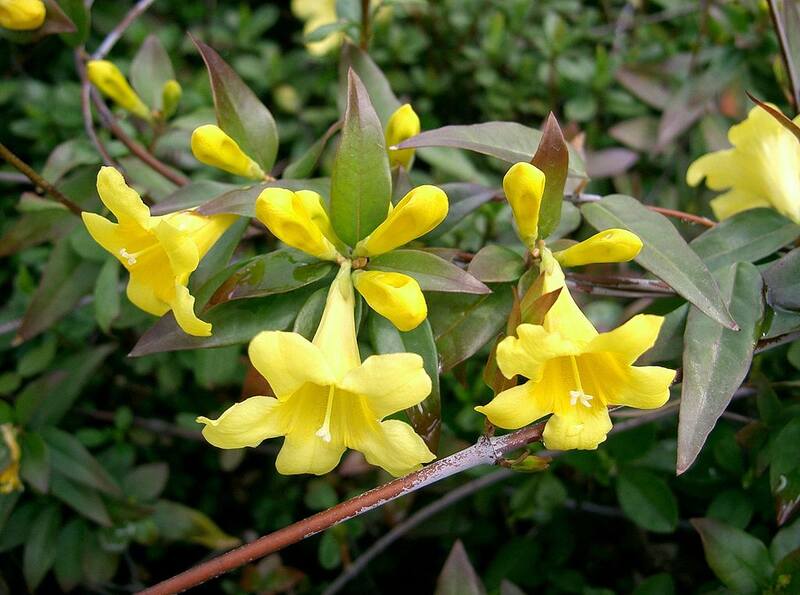
Photo Credit: KENPEI / Wikimedia Commons / CC BY-SA 3.0
Native to the southeastern United States, Carolina Jessamine is often found growing in forests, stream banks, and other natural areas. It’s particularly well-suited to the warm, humid climate of Central and South Florida.
With glossy, dark-green leaves, this evergreen vine produces vibrant, trumpet-shaped yellow flowers in late winter and early spring. It’s a larval host plant for several butterflies, including the Zarucco duskywing and the southern cloudywing.
If you are planting Carolina Jessamine in your garden, it is best to do so in the fall or winter. It prefers well-drained soil and will benefit from regular watering during the growing season. You may prune it occasionally to control its size and shape.
Growth habit: Vine
USDA Hardiness Zone: 6-10
Mature size: 10-20 feet tall
Duration: Perennial
Foliage: Evergreen
Sunlight needs: Full sun to partial shade – it can grow even with just 2-6 hours of direct sunlight a day
Soil preferences: Well-drained, moist, loamy soil with high organic matter
Water needs: Moderate
Potential hazards: All its parts are toxic if ingested, and its sap can cause allergic skin reactions in some people
8. Coontie (Zamia integrifolia)
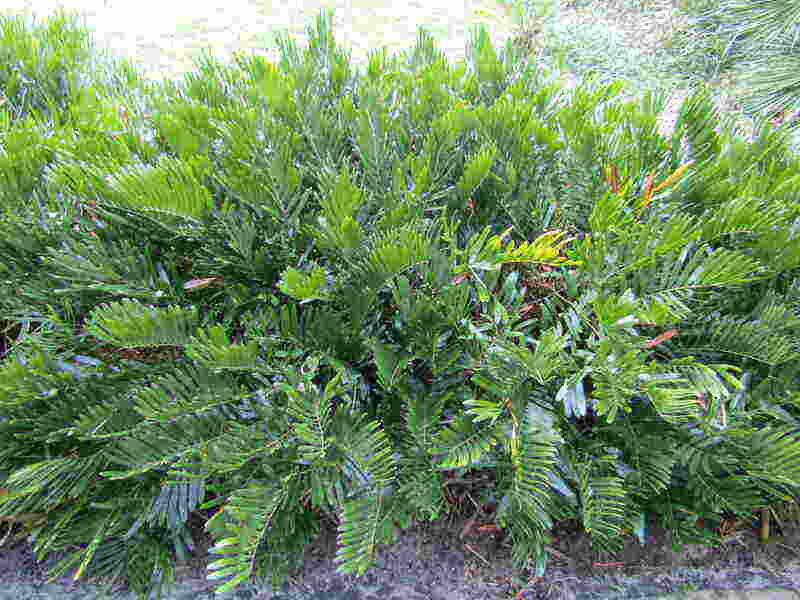
Photo Credit: Leonora (Ellie) Enking / Flickr / CC BY-SA 2.0
A slow-growing, evergreen plant, coontie is best for gardens in Central and South Florida. Its natural habitat is in sandy soils, coastal dunes, and pine rocklands, and it’s also found in the understory of hardwood hammocks.
The Atala butterfly, an endangered species native to Florida, relies only on this plant as its larval host. In fact, this prehistoric “living fossil” has survived for more than 200 million years and remains the sole cycad species in the United States.
This perennial shrub produces cones rather than flowers, with the female cone being bright orange and the male cone being brownish-green. The best time to plant coontie is in the fall or early winter. It’s drought-tolerant and requires minimal watering once established, making it an ideal choice for Florida’s sandy soils.
Growth habit: Shrub
USDA Hardiness Zone: 8a-11b
Mature size: 1-3 feet tall, 3-5 feet wide
Duration: Perennial
Foliage: Evergreen
Sunlight needs: Full sun to partial shade (two to six hours of sun per day)
Soil preferences: Well-drained, moist, fertile, sandy soil
Water needs: Low
Potential hazards: Toxic – all parts of the plant are poisonous
9. Coral Bean (Erythrina herbacea)
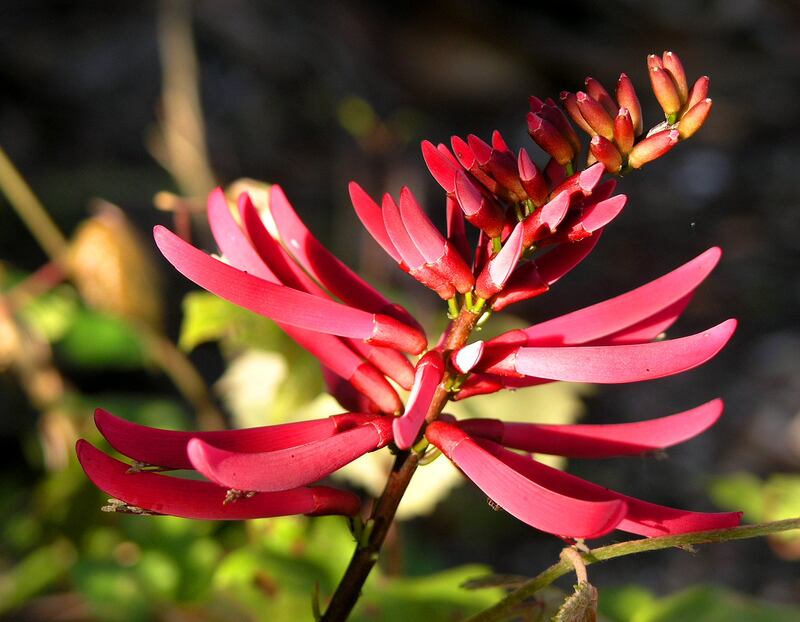
Photo Credit: Everglades National Park / Flickr / CC0 1.0
Native to Florida, coral bean can be found in sandy soils, pine rocklands, and coastal hammocks throughout the state. Although, it’s best suited for gardens in Central and South Florida due to its preference for warmer temperatures and more humid environments.
From late spring to early summer, this deciduous plant produces bright red flowers. It’s an excellent choice for gardeners looking to attract pollinators, as it is a larval host to several species of butterflies and moths. The best time to plant coral bean is in the fall or winter. Doing so will allow the plant to establish a strong root system before the heat of summer arrives.
This perennial shrub’s leaves are bright green and have a slightly rough texture, while its flowers are trumpet-shaped and grow in clusters. After the flowers fade, coral bean produces seed pods that contain bright red seeds. While these seeds may look beautiful, note that they are highly poisonous when ingested.
Growth habit: Shrub
USDA Hardiness Zone: 8-11
Mature size: 6-12 feet tall, 3-6 feet wide
Duration: Perennial (annual for regions with freezing winters)
Foliage: Deciduous
Sunlight needs: Full sun to partial shade
Soil preferences: Dry, well-drained, acidic, clay, sandy, or loamy soil
Water needs: Moderate
Potential hazards: Toxic – its seeds are very poisonous to humans, especially to small children
10. Coral Honeysuckle (Lonicera sempervirens)
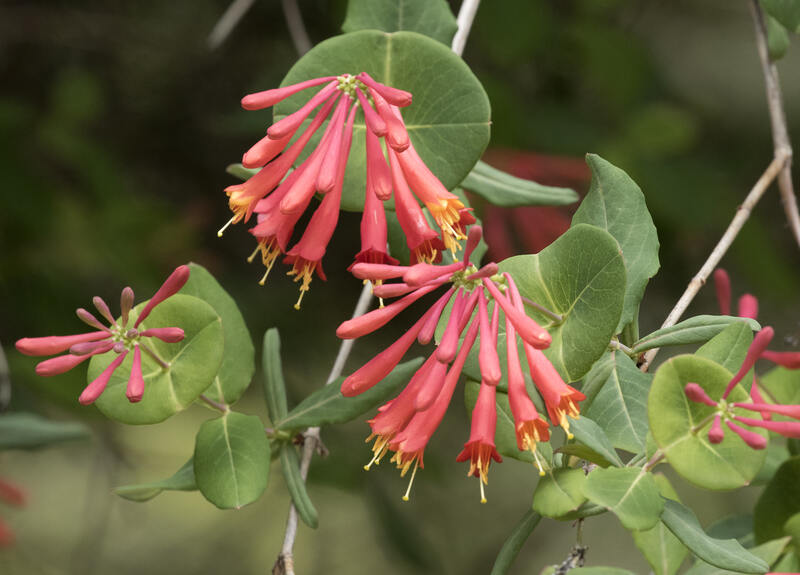
Photo Credit: Zeynel Cebeci / Wikimedia Commons / CC BY-SA 4.0
A beautiful, easy-to-grow plant perfect for Florida gardens, coral honeysuckle thrives in a wide range of habitats, including woodland edges, sandy dunes, and along riverbanks. It’s commonly found throughout Florida, as well as in many other parts of the southeastern United States.
This perennial vine blooms from spring to fall and produces tubular-shaped, coral-red flowers incredibly attractive to hummingbirds and other pollinators. Its foliage is deep green, and it remains evergreen throughout the year. It requires little maintenance and is generally resistant to pests and diseases.
Coral honeysuckle prefers moist soil but can tolerate drought once it’s established. You can train it to climb a trellis or fence or allow it to sprawl as a groundcover. It’s also a larval host plant for the spring azure butterfly, so it’s a great addition to butterfly gardens.
Growth habit: Vine
USDA Hardiness Zone: 4-10
Mature size: 3-20 feet (depending on its supporting structure)
Duration: Perennial
Foliage: Semi-evergreen to evergreen
Sunlight needs: Grows well in partial shade but prefers full sun
Soil preferences: Prefers well-drained, rich, slightly acidic soil but tolerates most soil types
Water needs: Moderate
Potential hazards: Its berries are toxic to humans and pets but favored by birds
11. Ear-Leaved Tickseed (Coreopsis auriculata)
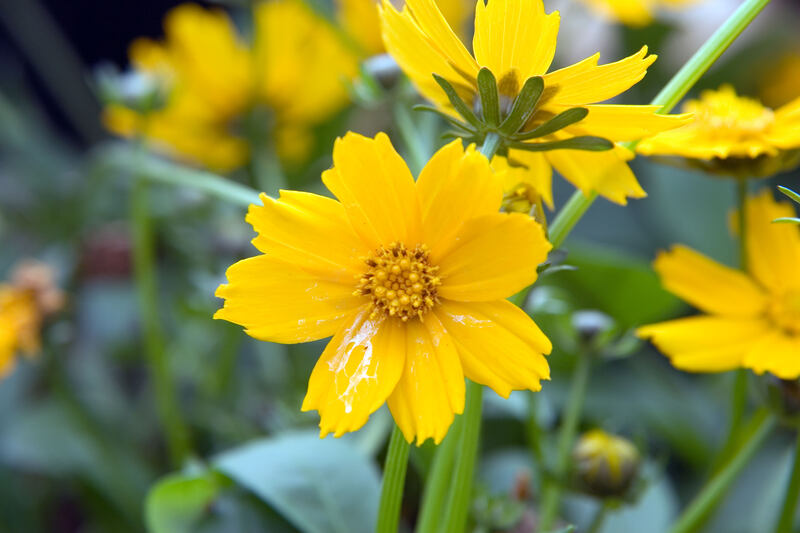
Photo Credit: David J. Stang / Wikimedia Commons / CC BY-SA 3.0
Commonly found in meadows, prairies, and woodland edges, ear-leaved tickseed attracts pollinators with its nectar-rich flowers. It also serves as a larval host to various species of butterflies, including zebra longwing – Florida’s state butterfly.
While it’s native to Florida and many other southeastern states, ear-leaved tickseed is best for gardens in Central and North Florida, as it thrives in sandy soils and frequent summer rainfalls. This plant produces an abundance of bright yellow flowers that bloom from spring to summer – perfect for homeowners who want to add a burst of color to their gardens.
The best time to plant ear-leaved tickseed is in the fall or spring – when the weather is cooler, and there is more moisture in the soil. Doing so will give the plant a better chance to establish its roots and grow strong before the hot summer months arrive.
Growth habit: Wildflower
USDA Hardiness Zone: 4a-9b
Mature size: 1-2 feet tall
Duration: Perennial
Foliage: Deciduous
Sunlight needs: Full sun to partial shade
Soil preferences: Dry, loamy, sandy soil
Water needs: Low
Potential hazards: Non-toxic
12. Firebush (Hamelia patens)
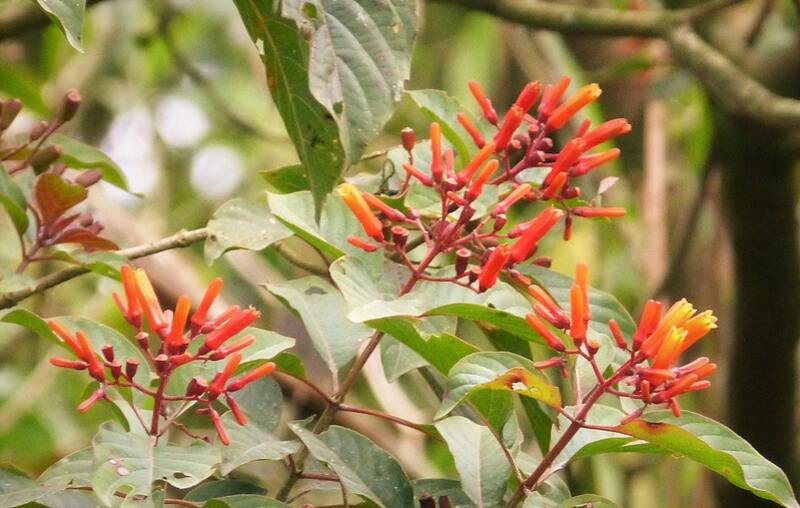
Photo Credit: gailhampshire / Flickr / CC BY 2.0
Firebush is salt-tolerant – a welcome trait for gardens across peninsular Florida. Often found in open woodlands, disturbed areas, and along the edges of swamps and ponds, this perennial shrub has glossy and dark green leaves.
It typically blooms from spring to fall, producing clusters of tubular, bright orange-red flowers that are irresistible to pollinators like butterflies, bees, and hummingbirds. After the flowers fade, firebush produces small red fruits – a favorite food of many bird species. It’s also a larval host plant for the common buckeye butterfly and the adult food source for the Pluto Sphinx moth.
Firebush is excellent for adorning patios, containers, or as borders. You should plant it in the spring or fall – before the heat of summer arrives. You also can use fertilizer to encourage healthy growth and more prolific blooming.
Growth habit: Shrub
USDA Hardiness Zone: 8-11
Mature size: 1-3 feet tall, 1-2 feet wide
Duration: Perennial
Foliage: Deciduous
Sunlight needs: Full sun to partial shade
Soil preferences: Well-drained, fertile, sandy soil
Water needs: Low – but it needs regular watering until fully established
Potential hazards: Non-toxic, but may cause skin irritation
13. Florida Anise (Illicium floridanum)
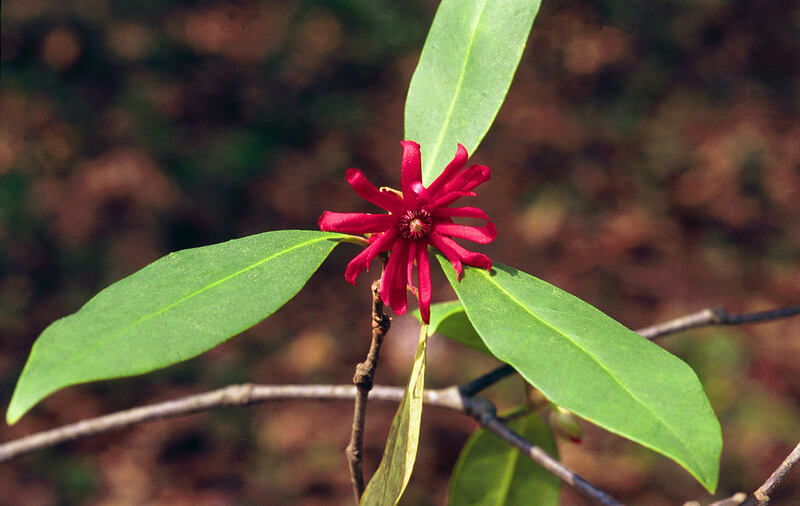
Photo Credit: Ted Bodner / Wikimedia Commons / CC BY 3.0 US
Also known as purple anise, Florida anise is a beautiful shrub native to Florida and other southeastern states. It’s sometimes called stinkbush because its leaves and twigs have a strong, musky odor that some people find unpleasant. It’s best suited for Central and North Florida gardens, as it can tolerate cooler temperatures. Although, it also can thrive in South Florida with proper care.
Commonly planted in shady areas and moist soils, such as swamps, riverbanks, and bogs, this evergreen plant blooms in early spring, producing clusters of dark red or maroon flowers attractive to butterflies and hummingbirds. It’s also a larval host to the pipevine swallowtail butterfly. With glossy and leathery, dark green leaves, Florida anise produces small, woody capsules of fruit that split open to reveal shiny black seeds.
It’s recommended to plant Florida anise when the soil is moist – in the fall or winter. Also, consider planting it with other shade-loving plants and incorporating it into a woodland garden design for a natural and wild look.
Growth habit: Shrub
USDA Hardiness Zone: 8-10
Mature size: 10-15 feet tall, 6-10 feet wide
Duration: Perennial
Foliage: Evergreen
Sunlight needs: Full sun to partial shade
Soil preferences: Moist, well-drained, fertile, clay, loamy, sandy soil
Water needs: Low – while it’s drought-tolerant, you will need to water it weekly during long periods of dry spells
Potential hazards: Toxic to humans and pets
14. Oakleaf Hydrangea (Hydrangea quercifolia)
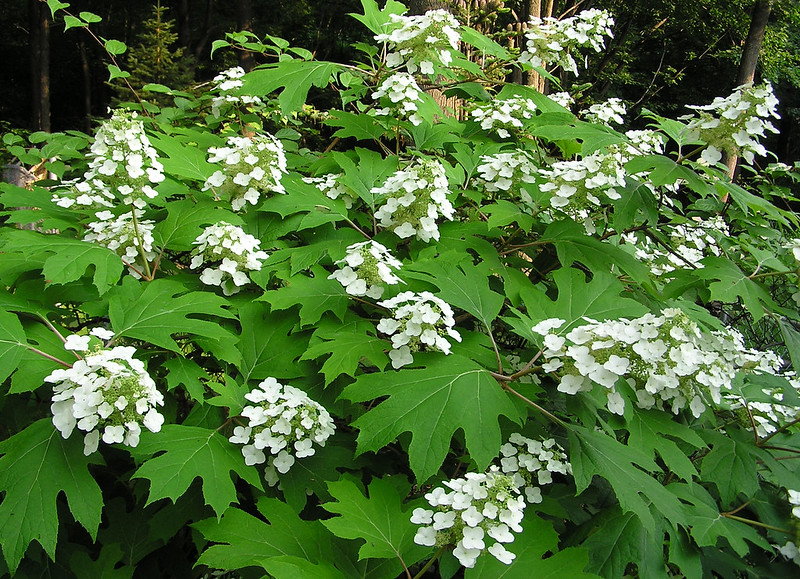
Photo Credit: normanack / Flickr / CC BY 2.0
Commonly found in woodland areas across the state, oakleaf hydrangea is well-suited to the humid climate and can thrive in a variety of Florida gardens. From late spring to early summer, it produces showy, cone-shaped flower clusters that are white or pinkish-white.
You should plant it in the fall when there’s more consistent rainfall and the temperature is lower. This deciduous shrub will lose its striking oak-like leaves in the winter but will turn a beautiful reddish color before falling off.
Consider planting it alongside other native plants, such as coneflowers or black-eyed Susans. It will create a stunning display of color and texture that will last for years.
Growth habit: Shrub
USDA Hardiness Zone: 5a-9b
Mature size: 4-8 feet tall
Duration: Perennial
Foliage: Deciduous
Sunlight needs: Full sun to partial shade
Soil preferences: Fertile, loamy, or sandy soil
Water needs: Moderate
Potential hazards: Toxic – every part of this plant is poisonous
15. Pink Pinxter Azalea (Rhododendron canescens)
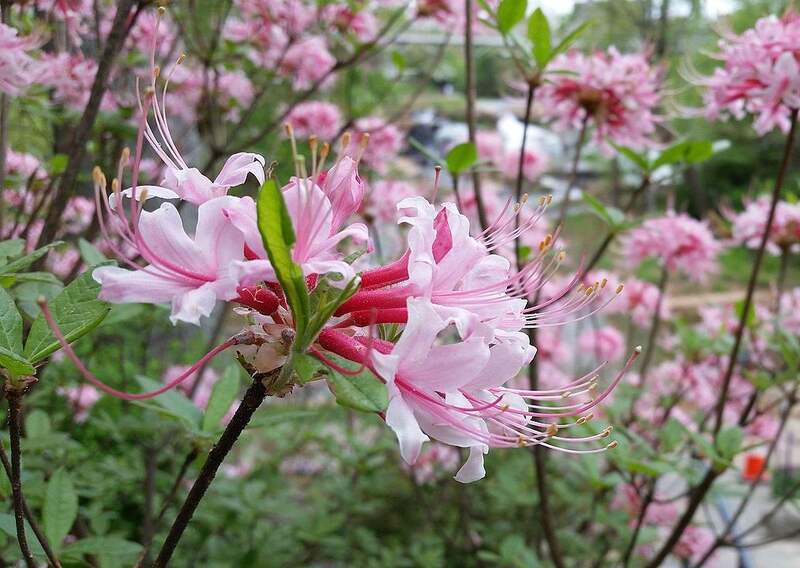
Photo Credit: EoRdE6 / Wikimedia Commons / CC BY-SA 4.0
Native to the Southeastern United States, pink pinxter azalea is commonly found in wooded areas and along streams. As it can thrive in cold temperatures, it’s best suited for gardens in North and Central Florida and is less tolerant of the hotter conditions of South Florida.
This perennial shrub blooms in the spring, usually in April or May, with clusters of pink or white, trumpet-shaped flowers that are attractive to pollinators like the Eastern tiger swallowtail butterfly. Remember to plant it in the fall or early winter when temperatures are cooler.
The leaves of pink pinxter azalea are medium green, with a leathery texture, and turn a reddish-purple color in the fall. To make it more beautiful in your garden, you can prune it after it blooms to encourage more branching and fuller growth. Also, this plant prefers moist soil, so keep it well-watered during dry spells.
Growth habit: Shrub
USDA Hardiness Zone: 5-9
Mature size: 6-15 feet tall, 6-10 feet wide
Duration: Perennial
Foliage: Deciduous
Sunlight needs: Partial shade
Soil preferences: Moist to dry, well-drained, acidic soil
Water needs: Moderate
Potential hazards: Highly toxic to both humans and pets
16. Saw Palmetto (Serenoa repens)
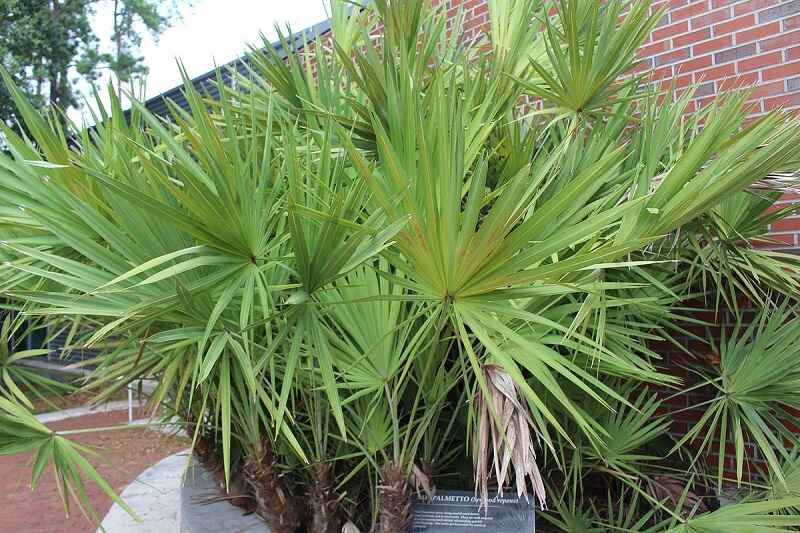
Photo Credit: Michael Rivera / Wikimedia Commons / CC BY-SA 4.0
A native Florida plant commonly found in dry, sandy areas like pine flatwoods and coastal scrubs throughout the state, saw palmetto can tolerate a wide range of soil and environmental conditions.
This hardy plant typically blooms from April to June, producing small yellowish-white flowers that are attractive to bees and other pollinators. It’s also a larval host plant for the palmetto skipper butterfly. With fan-shaped, blue-green leaves, this slow-growing plant produces small, dark blue-black berries – a favorite food of many wildlife, including bears, raccoons, and deer.
While saw palmetto is not poisonous, it’s essential to handle it carefully, as its leaves can be sharp and cause skin irritation. Additionally, it has been traditionally used for medicinal purposes and is believed to have various health benefits.
Growth habit: Shrub or small tree
USDA Hardiness Zone: 8-11
Mature size: 4-8 feet tall, 4-6 feet wide
Duration: Perennial
Foliage: Evergreen
Sunlight needs: Partial shade to full sun
Soil preferences: Well-drained, slightly acidic, loamy, sandy soil
Water needs: High
Potential hazards: Non-toxic
17. Scarlet Sage (Salvia coccinea)
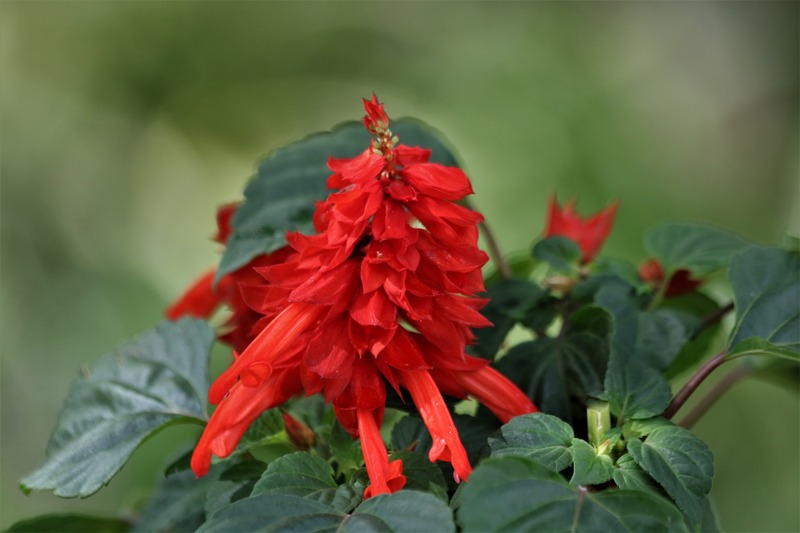
Photo Credit: PublicDomainPictures
Scarlet sage is an eye-catching flowering plant well-suited for gardens in all regions of Florida. It is particularly attractive to hummingbirds and butterflies, making it a favorite of gardeners who want to attract pollinators to their yards. Native to Florida, this evergreen plant can grow wild in various habitats, including woodlands, hammocks, and meadows.
From late spring through fall, this perennial plant produces beautiful bright red, pink, or white flowers. You can deadhead the spent blooms regularly to encourage new growth and prolong the blooming period.
The leaves of scarlet sage are deep green and have a slightly fuzzy texture, adding to its overall visual appeal. Its leaves’ pungent scent also makes it a deer-proof option. And if you want to maintain its shape and promote bushier growth, you may occasionally prune it.
Growth habit: Wildflower
USDA Hardiness Zone: 8-10
Mature size: 1-3 feet tall
Duration: Perennial – annual in regions with below-freezing winters
Foliage: Evergreen
Sunlight needs: Full sun to shade
Soil preferences: Moist to dry, clay, loamy, or sandy soil
Water needs: Moderate
Potential hazards: Toxic – its flowers can cause gastric distress
18. Southern Live Oak (Quercus virginiana)
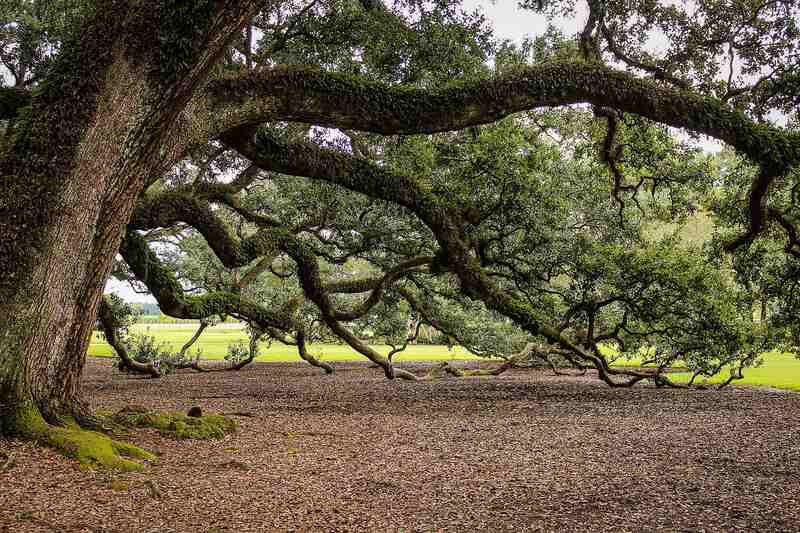
Photo Credit: Pixabay
A beautiful and iconic tree native to Florida, southern live oak is a popular choice for homeowners who want to add shade, beauty, and value to their properties. It’s a slow-growing evergreen and can live for a long time. It’s best suited for Central and South Florida properties due to its ability to tolerate salt spray and hot temperatures.
This majestic tree grows naturally in coastal areas, swamps, and along rivers, and its hardiness and durability make it ideal for landscapes that experience hurricanes and tropical storms. Southern live oaks don’t bloom in the traditional sense, but they produce acorns – an essential food source for deer, squirrels, birds, and other animals.
The best time to plant southern live oaks is in the fall or winter – when the tree is dormant. Regular pruning can help to maintain the tree’s shape and promote healthy growth. You can add understory plants and groundcovers to complement the tree’s beauty and create a naturalistic landscape.
Growth habit: Tree
USDA Hardiness Zone: 8a-10b
Mature size: 40-80 feet tall, 30-100 feet wide
Duration: Perennial
Foliage: Evergreen
Sunlight needs: Full sun to partial shade
Soil preferences: Moist, well-drained, loamy soil
Water needs: Low
Potential hazards: Toxic – avoid ingesting the acorns and leaves as they can be poisonous to both humans and animals
19. Southern Wax Myrtle (Myrica cerifera)
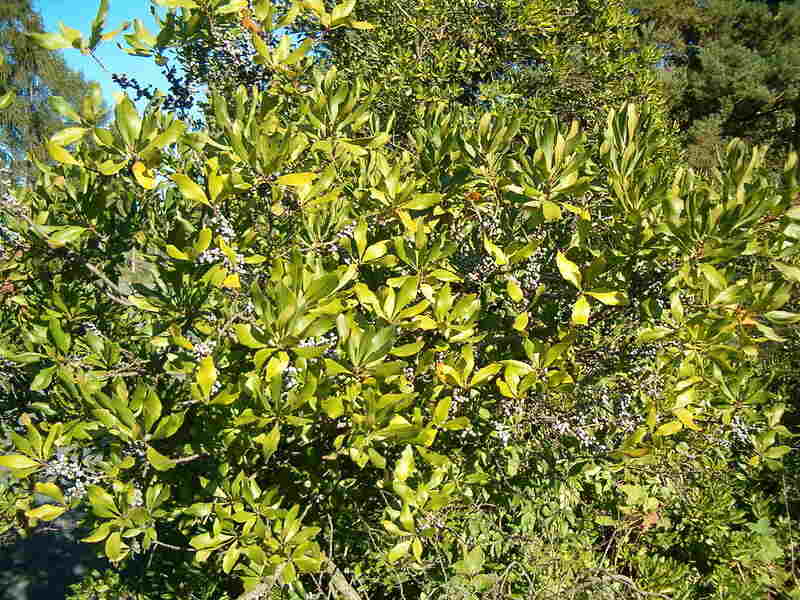
Photo Credit: BotBln / Wikimedia Commons / CC BY-SA 3.0
A versatile evergreen well-suited for gardens in all regions of Florida, southern wax myrtle has attractive green leaves with a leathery texture and a spicy, aromatic scent when crushed. It’s commonly found in natural habitats throughout the state, including wetlands, coastal dunes, and upland areas.
This evergreen blooms in early spring, producing tiny flowers and, eventually, clusters of small, waxy, blue-gray berries in the fall. Its berries are a food source for various birds and other wildlife. Plus, the plant is an essential host for several species of butterflies.
The best time to plant this drought-tolerant perennial is in the early fall or late winter, as these seasons provide optimal growing conditions. Consider planting it as a hedge, using it as a specimen plant, or incorporating it into a mixed border with other flowering plants. Its dense growth habit also makes it ideal for screening and privacy.
Growth habit: Tree or shrub
USDA Hardiness Zone: 7-11
Mature size: 20-25 feet tall and 8-10 feet wide
Duration: Perennial
Foliage: Evergreen
Sunlight needs: Partial shade to full sun, but can tolerate full shade
Soil preferences: Can grow well in most soils
Water needs: Moderate – needs watering every two weeks but can tolerate floods and drought once established
Potential hazards: Non-toxic
20. Texas Star Hibiscus (Hibiscus coccineus)
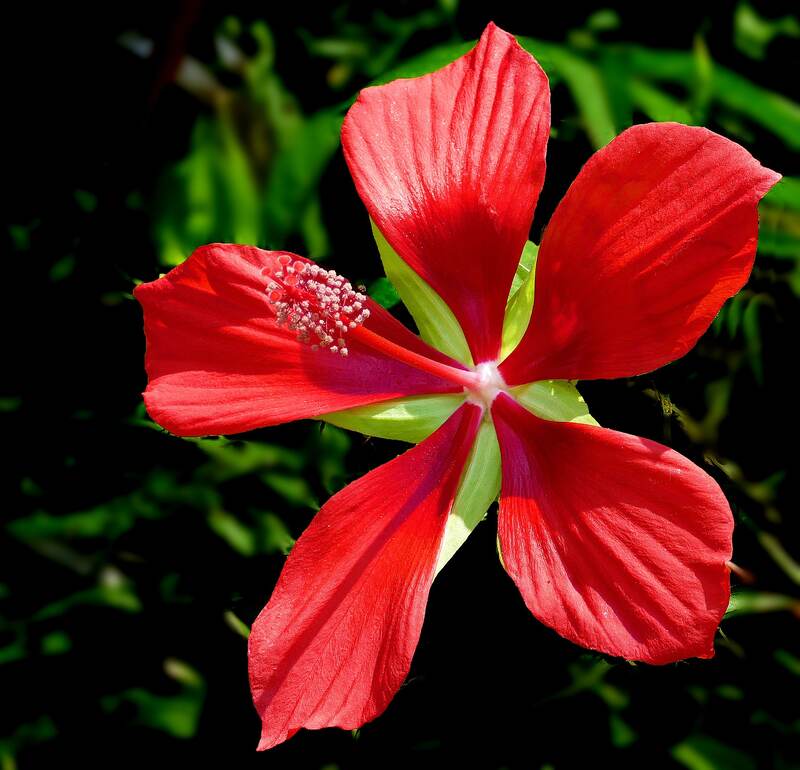
Photo Credit: Jim Evans / Wikimedia Commons / CC BY-SA 4.0
Well-suited for gardens in Central and North Florida, Texas star hibiscus is commonly found in wetlands and along waterways in these regions. It’s often used in landscaping around retention ponds and other water features.
Also known as the scarlet rose mallow, this vibrant plant blooms in late summer and early fall. It produces showy, large flowers in shades of red, pink, and white. It’s an excellent choice for attracting pollinators like bees and butterflies to your garden.
Remember to plant Texas star hibiscus when there’s no more threat of frost – in the spring. While it requires regular watering, particularly in the hot summer months, don’t overwater as it does not tolerate standing water.
Growth habit: Wildflower
USDA Hardiness Zone: 5-9
Mature size: 6-8 feet tall
Duration: Perennial
Foliage: Deciduous
Sunlight needs: Full sun to partial shade
Soil preferences: Prefers moist soil but grows well in most soil types
Water needs: High – needs 1-3 inches of water per week, even more during dry spells
Potential hazards: Non-toxic
21. Walter’s Viburnum (Viburnum obovatum)

Photo Credit: Katja Schulz / Flickr / CC BY 2.0
Also known as sweet viburnum, Walter’s viburnum is a beautiful and hardy shrub native to Florida. While its natural habitat includes wetlands, flatwoods, and hammocks, it’s also well-suited to suburban landscapes.
As it thrives in warm and humid climates, Walter’s viburnum is ideal for gardens in Central and South Florida. This shrub blooms in late winter to early spring with small white flowers that mature into clusters of bright red berries, making it an excellent food source for wildlife.
Ideal for use in hedges and privacy screens, Walter’s viburnum is best planted in the fall or winter. Prune it to maintain its shape and remove dead or damaged branches.
Growth habit: Shrub to small tree
USDA Hardiness Zone: 7-10
Mature size: 8-25 feet tall
Duration: Perennial
Foliage: Evergreen to semi-evergreen in regions with mild winters
Sunlight needs: Partial sun to full sun
Soil preferences: Moist, well-drained, clay, sandy soils
Water needs: Low, but water it often until established (six to 12 months after planting)
Potential hazards: Non-toxic
How to Choose Native Plants for Your Florida Landscape
Florida boasts a wide variety of native flora, ranging from vibrant wildflowers to verdant shrubs and trees. With average lows ranging from 41 to 65 Fahrenheit, the Sunshine State’s climate is highly conducive to the growth of numerous native plant species.
For your garden, choose plant species that are well-suited to your specific region and environmental conditions.
North Florida
In the state’s northern region, you’ll find a variety of native plant species, such as wildflowers, shrubs, and trees, including muhly grass, azaleas, and yuccas. When selecting plants for your yard, you may need to choose the ones that can withstand occasional cold snaps. Additionally, you need to consider shade exposure and other factors, including:
- USDA hardiness zone: 8-9
- Average highs: Mid-60s to mid-80s Fahrenheit
- Rainfall: Ranges from 50 to 65 inches
Central Florida
With a humid subtropical climate, Central Florida’s soils are typically sandy, and the area receives ample rainfall throughout the year. Native plant species that thrive in this region include palms, oaks, and magnolias. Consider adding plants like beach sunflower, coontie, passion flower, and Fakahatchee grass that can tolerate high humidity and heat and thrive in these conditions:
- USDA hardiness zone: 9-10
- Average highs: Mid-70s to mid-90s Fahrenheit
- Rainfall: Ranges from 40 to 60 inches
South Florida
South Florida’s tropical climate makes it a paradise for native plants. The soil and climate in this region are ideal for various plants, from wildflowers to palms and ferns. Plants that thrive here include saw palmetto, coral bean, and gumbo limbo. If you live near the coast, consider plants like seagrape and wild coffee that can tolerate salt spray, as well as the following factors:
- USDA hardiness zone: 10-11
- Average highs: Mid-80s to mid-90s Fahrenheit
- Rainfall: Ranges from 40 to 60 inches
Additionally, you need to consider the plant’s size, growth habit, and maintenance needs. To learn more about Florida’s native flora and fauna, visit one of the state’s many botanical gardens and nature preserves. They often feature extensive collections of native plants, as well as educational programs and events that highlight the importance of native species in maintaining healthy ecosystems.
FAQ About Florida Native Plants
Florida has an array of soils due to its varied topography, but the majority of the state has sandy soil, with some areas containing high levels of organic matter. The sandy nature of the soil is due to Florida’s geological history, which includes marine sediments and ancient beach dunes.
● North Florida: The northern part of Florida generally has more acidic soil with higher sand content, but some areas have loamy and clay soil. These soils are typically low in nutrients and organic matter, so adding compost or other organic materials can help improve soil quality.
● Central Florida: This region has a mix of sandy and clay soils, with some areas having more sand and others having more clay. These soils are low in nutrients and organic matter, so adding amendments like compost or fertilizers can be beneficial.
● South Florida: The southern part of Florida has more alkaline soil and higher clay content. But some areas in this region have acidic, sandy, and limestone-based soil with low levels of organic matter, making it difficult for plants to absorb nutrients. Adding soil amendments like lime can help raise pH levels and improve soil quality.
Florida’s soils also can vary in water-holding capacity, drainage, and nutrient content. Regardless of where you live in Florida, you must test your soil to determine its pH and nutrient levels.
To determine the soil type in your yard, you can perform a simple soil test or consult a local nursery or extension office. It can help you decide on the kinds of plants that will thrive in your landscape and ensure they receive the proper care they need.
The best time to plant native flowers and shrubs in Florida depends on the specific plant and location. Fall and winter are generally the best times to plant in Florida.
In the northern parts, where the climate is cooler, fall is the best time to plant as it allows the roots to establish before the colder winter months. For gardens in Central Florida, fall and winter are still ideal for planting, but the warmer climate allows for some planting to be done in early spring.
In South Florida, where the weather is tropical and subtropical, planting can be done year-round, but the best time is in the winter months when the temperatures are cooler, and there is less rain.
An excellent option for Florida homeowners is Zoysiagrass. This grass type is known for its durability and drought resistance, making it a fantastic choice for Florida’s hot and dry summers. Zoysiagrass also has a fine texture and low-growing habit, making it perfect for those who prefer a more manicured lawn.
Other turfgrass varieties that may complement Florida native plants include bahiagrass, centipedegrass, and bermudagrass. And if you’re not a fan of traditional grass lawns, ground covers are a great alternative, as they provide a low-growing carpet-like appearance that requires less maintenance.
Where to Find Native Plants in Florida
Interested in adding Florida native plants to your garden? You can start by visiting local nurseries and garden centers that specialize in native plants. These stores often carry a vast range of native species, and their staff can offer helpful advice on selecting the right plants for your garden.
Another great resource is the Florida Native Plant Society, which promotes using wildflowers and native plants in public and private landscapes. Their website provides information on where to find native plants, how to care for them, and how to incorporate them into your landscape.
You also can visit local farmers’ markets and plant sales, often featuring native plants and herbs grown by farmers and gardeners. These events will give you an opportunity to meet other plant enthusiasts and get tips on gardening with native species.
Whether you live in St. Augustine, Miami, Jacksonville, Orlando, Tampa, Pensacola, or another city in the Sunshine State, consider hiring a landscaping pro to help design and maintain your beautiful, eco-friendly garden.
Main Image Credit: James St. John / Wikimedia Commons / CC BY 2.0